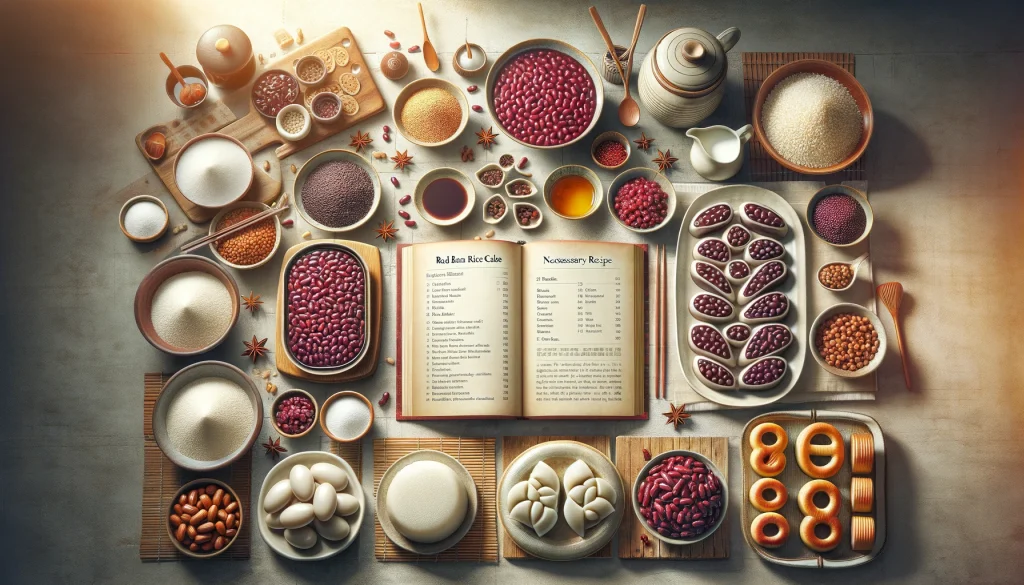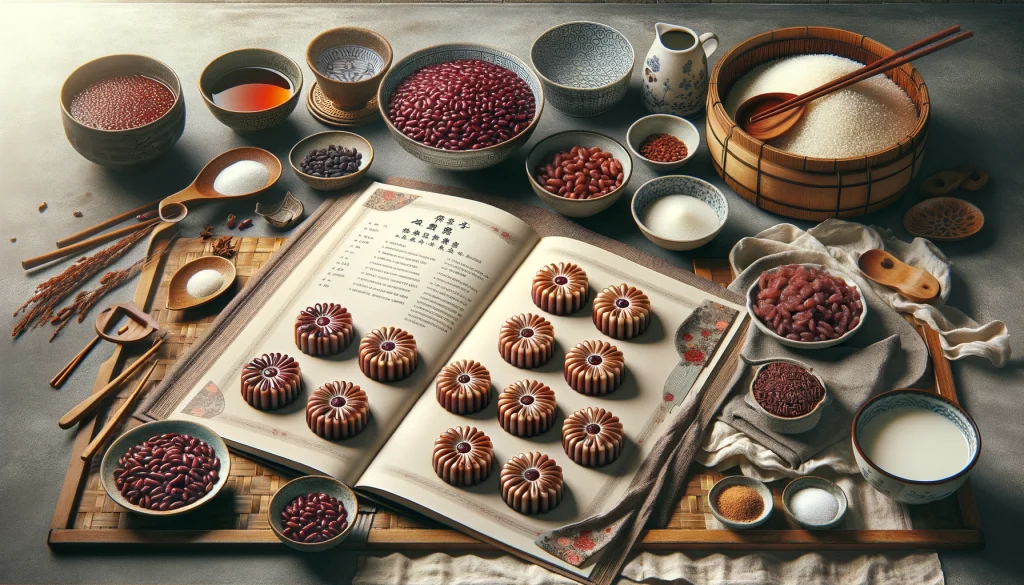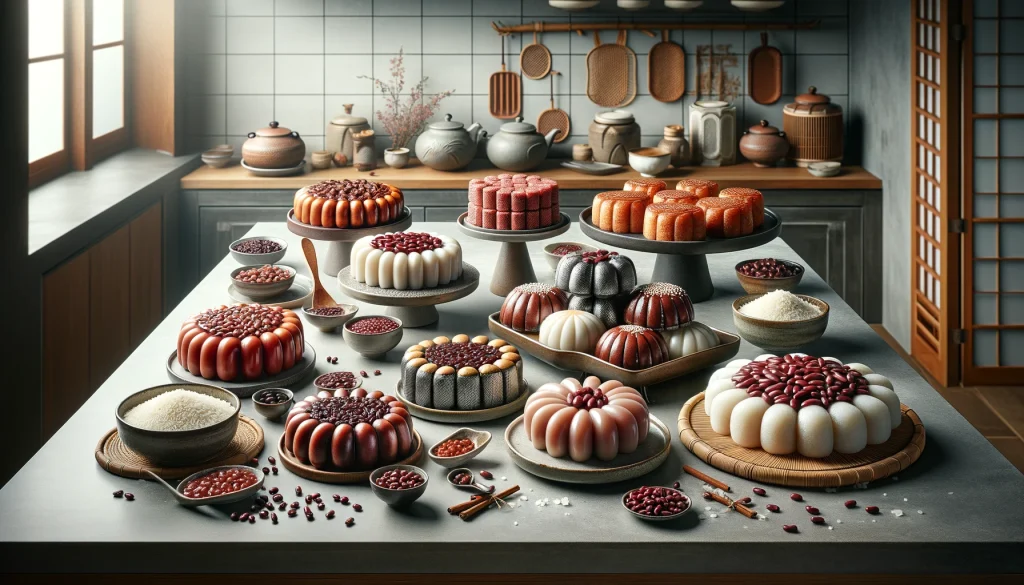As an Amazon Associate I earn from qualifying purchases.
Delve into the heartwarming flavors of Asian confectionery with our irresistible Red Bean Rice Cake recipe. Bursting with the sweet essence of homemade red bean paste and the comforting chewiness of glutinous rice, this delicacy offers a delightful fusion of texture and taste. Perfect for celebrations, gatherings, or simply satisfying your sweet cravings, our recipe invites you to embark on a culinary journey steeped in tradition and flavor. Join us as we explore the art of crafting this beloved dessert, sharing not just a recipe but a piece of cultural heritage to be savored and shared with loved ones.
Sweet Red Bean Rice Cake Recipe

Indulge in the sweet harmony of flavors with this Red Bean Rice Cake recipe, a delightful treat inspired by traditional Asian desserts. Red bean paste, known for its sweet, earthy flavor, pairs exquisitely with the soft, chewy texture of glutinous rice cakes. This recipe is perfect for those looking to explore the comforting flavors of Asian confectionery at home.
Ingredients:
For the Red Bean Paste:
- 1 cup dried adzuki beans
- Water for soaking and cooking
- 3/4 cup sugar (adjust according to taste)
- Pinch of salt
- 1/4 cup vegetable oil (optional, for a smoother texture)
For the Rice Cake:
- 2 cups glutinous rice flour (also known as sweet rice flour)
- 1 cup water (adjust as needed)
- 1/2 cup sugar
- 1 teaspoon baking powder (optional, for a lighter texture)
- Pinch of salt
Instructions:
Preparing the Red Bean Paste:
- Soak the Adzuki Beans: Rinse the adzuki beans thoroughly, then soak them in water overnight to soften.
- Cook the Beans: Drain the soaked beans and transfer them to a pot. Add fresh water to cover the beans by a few inches. Bring to a boil, then reduce the heat and simmer until the beans are soft and easily mashed, about 1 hour. Add more water as needed during cooking.
- Make the Paste: Once the beans are soft, drain any excess water. Add sugar and a pinch of salt to the beans and mash until smooth. For a smoother texture, you can add vegetable oil and blend the mixture using a hand blender or food processor.
- Cook the Paste: Return the bean paste to the pot and cook over low heat, stirring constantly to prevent sticking, until the paste thickens and can hold its shape. Set aside to cool.
Making the Rice Cake:
- Mix the Dry Ingredients: In a large bowl, combine the glutinous rice flour, sugar, baking powder (if using), and a pinch of salt.
- Add Water: Gradually add water to the dry ingredients, mixing until a smooth, thick batter forms. Adjust the water as needed; the batter should be pourable but not too runny.
- Prepare the Steamer: Line a steamer basket with parchment paper or lightly grease it to prevent sticking. Preheat the steamer.
- Layer the Batter and Red Bean Paste: Pour half of the rice batter into the prepared steamer basket. Spread a layer of red bean paste over the batter, leaving a small margin around the edges. Cover the red bean paste with the remaining rice batter.
- Steam the Cake: Steam the cake over medium-high heat for about 40-50 minutes, or until the rice cake is set and a toothpick inserted into the center comes out clean.
- Cool and Serve: Allow the cake to cool slightly before removing it from the steamer. Slice and serve warm or at room temperature.
Tips for a Perfect Red Bean Rice Cake:
- Consistency of the Paste: Ensure the red bean paste is thick enough before layering it with the rice batter to prevent it from sinking.
- Steamer Water Level: Check the water level in your steamer occasionally to ensure it doesn’t run dry during the cooking process.
- Cooling Time: Letting the cake cool for a while makes it easier to slice and helps set the texture.
This red bean rice cake recipe brings a piece of Asian dessert culture into your kitchen, perfect for celebrating traditional festivals or enjoying as a special treat. The sweet red bean paste complemented by the soft, chewy texture of the rice cake creates a unique and satisfying dessert experience.
Expert Tips for Perfecting Your Red Bean Rice Cake Recipe

- Quality Ingredients: Start with high-quality ingredients, especially when making the red bean paste. Opt for good quality adzuki beans and use fresh, wholesome glutinous rice flour for the best results.
- Soaking and Cooking Beans: Allow sufficient time for soaking the adzuki beans to ensure they soften properly. When cooking the beans, simmer them gently until they are tender enough to mash easily. This step is crucial for achieving a smooth and creamy red bean paste.
- Balancing Sweetness: Adjust the amount of sugar in the red bean paste according to your taste preferences. Taste the paste as you go and add sugar gradually until you reach the desired level of sweetness. Keep in mind that the sweetness of the rice cake will also contribute to the overall flavor.
- Texture of Red Bean Paste: Experiment with the texture of the red bean paste to suit your preference. Some people enjoy a smoother paste, achieved by blending the cooked beans, while others prefer a chunkier texture with whole beans intact. You can also add a splash of coconut milk for added richness and flavor.
- Layering Technique: When layering the red bean paste between the rice cake batter, ensure an even distribution to prevent uneven cooking. Spread the red bean paste evenly over the first layer of batter, leaving a small border around the edges to prevent leakage during steaming.
- Steaming Process: Monitor the steaming process closely to prevent overcooking or undercooking the rice cake. Keep the steamer covered throughout the cooking time to maintain a consistent temperature and prevent condensation from dripping onto the cake.
- Cooling and Slicing: Allow the rice cake to cool slightly after steaming before slicing. This allows the cake to set and firm up, making it easier to slice into neat portions. Use a sharp knife dipped in hot water to ensure clean cuts without sticking.
- Storage and Serving: Store any leftover rice cake in an airtight container in the refrigerator for up to a few days. Reheat gently in the steamer or microwave before serving to restore its soft and chewy texture. Serve the red bean rice cake as a delightful dessert or snack, accompanied by a cup of tea or coffee for a perfect pairing.
By following these expert tips, you’ll be well on your way to mastering the art of making red bean rice cake, creating a delectable treat that’s sure to impress friends and family alike. Enjoy the process of experimenting with flavors and techniques to create your own signature version of this classic Asian dessert!
Why This Recipe Is Just So Good…
This red bean rice cake recipe offers a harmonious blend of flavors, textures, and cultural influences that make it a standout dish. Here’s why this recipe is just so good:
- Rich Cultural Heritage: This recipe draws inspiration from Asian culinary traditions, specifically the use of adzuki beans in desserts. By incorporating these cultural elements, the recipe provides a taste of authenticity and heritage.
- Perfect Balance of Sweetness: The red bean paste, made from scratch using adzuki beans and sugar, provides a naturally sweet and earthy flavor profile. This sweetness is perfectly balanced by the slightly savory and chewy glutinous rice cake layers, creating a delightful contrast of tastes.
- Soft and Chewy Texture: The glutinous rice flour used in this recipe yields a soft, chewy, and slightly sticky texture, characteristic of traditional rice cakes. This texture pairs wonderfully with the creamy consistency of the red bean paste, offering a satisfying mouthfeel with every bite.
- Versatility: While this recipe highlights the classic combination of red bean paste and glutinous rice cake, it also allows for customization and adaptation. Whether you choose to experiment with different fillings, flavors, or toppings, this recipe serves as a versatile base for creating unique variations to suit your preferences.
- Simple Yet Elegant Preparation: Despite its impressive flavors and textures, this recipe is relatively simple to prepare, making it accessible to cooks of all skill levels. With clear instructions and readily available ingredients, anyone can recreate this delightful dessert at home.
- Nostalgic Comfort: For those familiar with Asian desserts featuring red bean paste and glutinous rice cakes, this recipe may evoke feelings of nostalgia and comfort associated with childhood memories or cultural celebrations. It’s a dish that resonates on an emotional level, making it all the more enjoyable to savor.
- Health Benefits: Red beans are packed with nutrients such as protein, fiber, and various vitamins and minerals, making them a nutritious addition to your diet. When paired with glutinous rice, which is gluten-free and low in fat, this recipe offers a wholesome treat that can be enjoyed guilt-free.
In summary, this red bean rice cake recipe stands out for its cultural significance, balanced flavors, delightful textures, versatility, ease of preparation, emotional resonance, and nutritional value. These elements combine to create a dish that is not only delicious but also deeply satisfying on multiple levels, making it truly exceptional.
Storage Instructions
To ensure the longevity and freshness of your red bean rice cake, follow these storage instructions:
- Cooling: Allow the red bean rice cake to cool completely at room temperature before storing. This helps prevent condensation, which can make the cake soggy.
- Wrap: Once cooled, wrap the red bean rice cake tightly in plastic wrap or aluminum foil to protect it from exposure to air, moisture, and odors.
- Airtight Container: Place the wrapped rice cake in an airtight container to further shield it from external elements and help maintain its texture and flavor.
- Refrigeration: Store the wrapped rice cake in the refrigerator for optimal freshness. The cool temperature of the refrigerator slows down microbial growth and helps extend the shelf life of the cake.
- Labeling: If storing multiple items in the refrigerator, label the container with the date of preparation to keep track of freshness and ensure timely consumption.
- Reheating: When ready to enjoy, gently reheat the refrigerated red bean rice cake in a steamer or microwave until warmed through. This helps restore its soft and chewy texture.
- Storage Duration: Red bean rice cake can typically be stored in the refrigerator for up to 3-5 days. Beyond this timeframe, the quality and freshness may begin to decline.
- Freezing (Optional): If you need to store the rice cake for a longer period, consider freezing it. Wrap the rice cake tightly in plastic wrap, then place it in a freezer-safe bag or container. Properly stored, red bean rice cake can be frozen for up to 1-2 months. Thaw overnight in the refrigerator before reheating.
By following these storage instructions, you can prolong the shelf life of your red bean rice cake and ensure that it remains delicious and enjoyable for as long as possible.
Frequently Asked Questions (FAQ)

Q: Can I use canned red bean paste instead of making it from scratch?
A: Yes, you can use canned red bean paste as a convenient alternative to homemade paste. It saves time and ensures consistency in texture and sweetness. Adjust the amount based on your taste preferences and the sweetness of the brand you’re using.
Q: Is there a substitute for glutinous rice flour?
A: Glutinous rice flour is unique in its ability to create a chewy and sticky texture. While there isn’t a direct substitute that will yield the exact same texture, in a pinch, you could try using rice flour for a different texture, or mochiko (sweet rice flour), which is similar but might have slight variations in results.
Q: How do I prevent my rice cake from being too dense or hard?
A: To prevent the rice cake from becoming too dense or hard, make sure not to overmix the batter, as this can lead to a tough texture. Also, ensure that the water-to-flour ratio is correct; too little water can result in a hard cake. Steaming on a consistent medium-high heat and not overcooking are also key points.
Q: Can I add or substitute other fillings instead of red bean paste?
A: Absolutely! This recipe is versatile. You can substitute red bean paste with other sweet fillings such as lotus seed paste, black sesame paste, or even sweetened coconut. Feel free to experiment with fillings according to your taste preferences.
Q: How do I know when the rice cake is fully cooked?
A: The rice cake is fully cooked when it has a consistent, slightly translucent appearance, and a toothpick or skewer inserted into the center comes out clean. The texture should be soft and slightly chewy. Steaming time may vary based on thickness and steamer used, so it’s always good to check around the 40-minute mark and adjust accordingly.
Q: My red bean rice cake turned out too sticky. What went wrong?
A: If the rice cake is excessively sticky, it might be due to too much water in the batter or undercooking. Ensure you measure ingredients accurately and adjust the steaming time as needed. Allowing the cake to cool before slicing can also help manage stickiness.
Q: Can I make this recipe vegan?
A: The basic recipe for red bean rice cake is naturally vegan, as it primarily consists of adzuki beans, sugar, and glutinous rice flour. Just ensure that any additional ingredients or substitutes align with vegan dietary requirements.
Q: How should I serve the red bean rice cake?
A: Red bean rice cake can be served warm or at room temperature. It’s often sliced into pieces for easy serving. You can accompany it with tea or other beverages. For an added touch, sprinkle some powdered sugar or coconut flakes on top before serving, if desired.
Q: Is red bean rice cake gluten-free?
A: Yes, this red bean rice cake recipe is gluten-free, as it uses glutinous rice flour, which does not contain gluten. However, always check the labels of your ingredients to ensure they are processed in a gluten-free facility if cross-contamination is a concern.
Q: Can I freeze the leftover rice cake?
A: Yes, the red bean rice cake freezes well. Wrap individual slices or the entire cake securely in plastic wrap and place it in a freezer-safe bag or container. When ready to enjoy, thaw in the refrigerator overnight and reheat gently to restore its texture.
Q: Can I make red bean rice cakes without a steamer?
A: Yes, you can pan-fry or bake them as alternatives. Pan-frying gives a crispy exterior, while baking can offer a softer texture similar to steamed versions.
Q: How long can you store red bean rice cakes?
A: They can be stored in an airtight container in the refrigerator for up to a week or frozen for longer storage. Thaw overnight in the refrigerator before reheating or serving.
Conclusion
In crafting this red bean rice cake, we’ve ventured through a process that is as enriching as it is delicious. This recipe stands as a testament to the timeless allure of traditional Asian desserts, offering layers of soft, chewy texture paired with the rich, sweet filling of red bean paste. It’s a celebration of simplicity and flavor, proving that sometimes, the most satisfying treats come from the most basic of ingredients, brought together with care and respect for the culinary traditions they represent.
Whether you’re new to the world of Asian desserts or revisiting familiar flavors, this red bean rice cake recipe promises to add a touch of sweetness and a lot of warmth to your table. It invites you to slow down, to savor each bite, and to appreciate the cultural stories woven into each layer. As you share this dessert with family and friends, you’re not just sharing food; you’re sharing a piece of heritage, a moment of connection, and the joy of discovering flavors that have delighted generations.
So, as we conclude our culinary journey with this red bean rice cake, remember that the true essence of cooking lies in exploration, in the joy of sharing, and in the celebration of flavors that bring us together. Let this recipe be a starting point for more delicious adventures, a reminder of the beauty of tradition, and a call to keep these flavors alive in our kitchens and our hearts. Happy cooking, and even happier eating!






